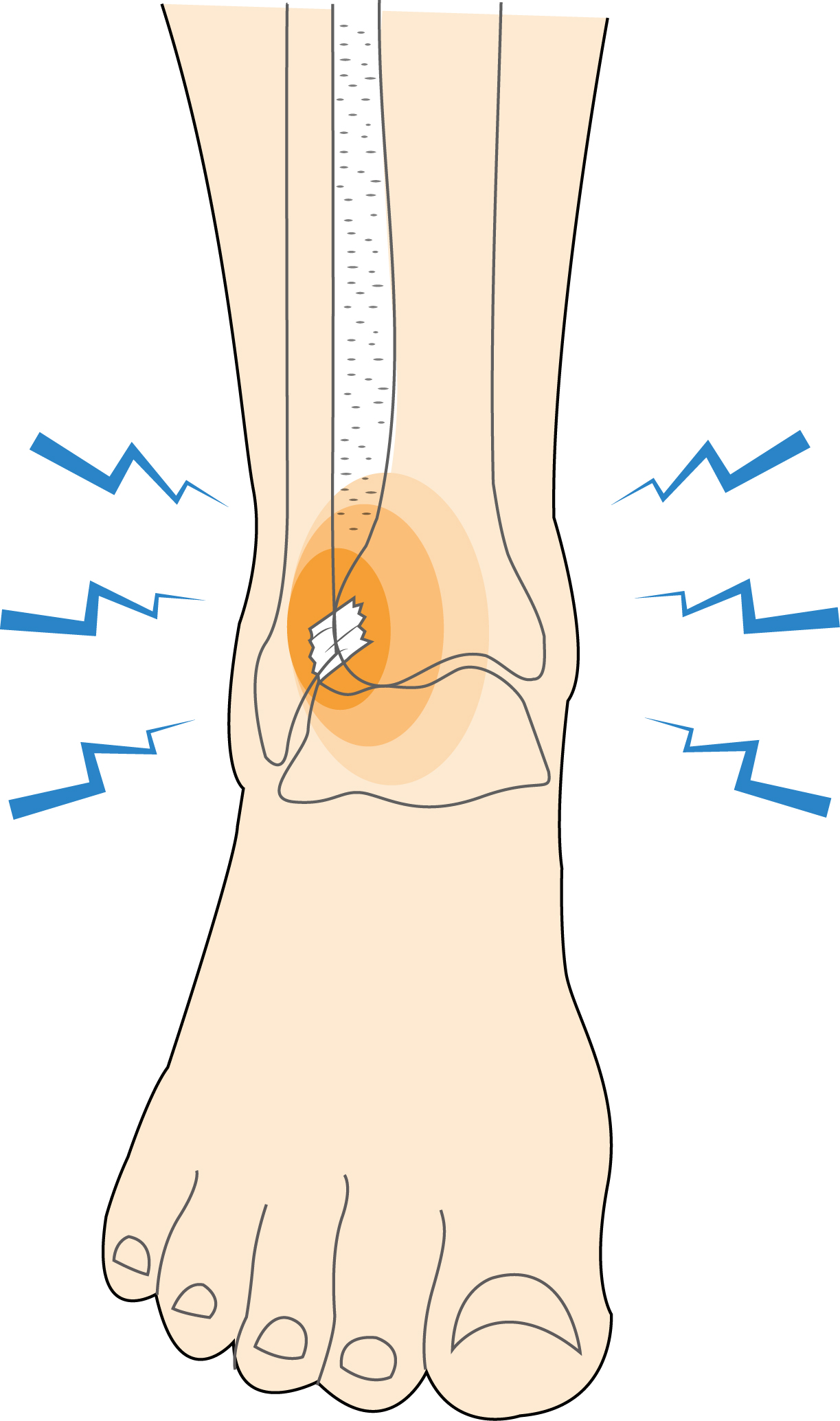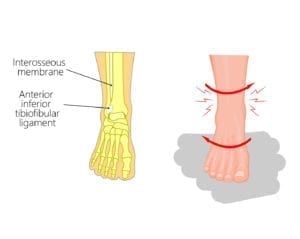A syndesmotic ankle sprain, also called a “high ankle sprain,” is a tearing of ligaments above the ankle. These ligaments, tough bands of fibrous tissue, connect the tibia and fibula, the two shin bones that comprise the lower leg. This tibiofibular ligament injury occurs less frequently than other ankle sprains, but can require a longer recovery time.
Ankle Sprain (Syndesmotic) Causes, Symptoms & Treatment
A syndesmotic ankle sprain, also called a “high ankle sprain,” is a tearing of ligaments above the ankle. These ligaments, tough bands of fibrous tissue, connect the tibia and fibula, the two shin bones that comprise the lower leg. This injury occurs less frequently than other ankle sprains but can require a longer recovery time.
Overview
Overview

What causes Ankle Sprain (Syndesmotic)?
High ankle sprains usually happen when the foot is planted on the ground and turns forcefully towards the outside, away from the leg. It is most commonly seen in impact sports. It may also occur in athletes with severe ankle fractures.
High ankle sprains are most common in these sports:
• Soccer
• Football
• Basketball
• Wrestling
• Lacrosse

Symptoms
Athletes with a high ankle sprain usually feel pain above the ankle, especially when they rotate their ankle towards the outside of their leg. Symptoms associated with a syndesmotic ankle sprain will depend on the degree of damage to the ligaments in your ankle.
Common symptoms also include:
• Pain and swelling above the ankle
• Pain in the leg near the knee
• Bruising in the lower leg near the ankle
• Inability to put weight on the ankle
When to see a doctor
If your ankle becomes swollen and painful to walk on, you should consult with your doctor. As surgery may be necessary for some high ankle sprains (see below), you must see your physician if you cannot bear weight on your ankle or if you have any other symptoms of a high ankle sprain. During your visit, your doctor will ask questions about your mechanism of injury,, the symptoms, and the sports you play. During the physical examination, your doctor will press your ankle to see if your ligaments are damaged. A squeeze test may also be performed, in which your doctor squeezes your leg just below your knee. If the pain radiates above your ankle, you may have a high ankle sprain. A weight-bearing x-ray may also be ordered to see if your shin bones have fractured or moved apart to form a gap.
Non-operative treatment
Syndesmotic ankle sprains are generally treated without surgery as long as they are only partial. Treatment usually involves rest and keeping weight off your ankle. Conservative treatments also include:
• Ice for 20 minutes every two to three hours
• Elevating the ankle
• Compression with an Ace bandage for stability
• Nonsteroidal anti-inflammatory drugs (NSAIDs), such as ibuprofen and naproxen, to relieve pain
• Wearing a special ankle brace or cast to support your ankle and protect it from re-injury
• Physical therapy exercises
You can also try these exercises at home:
Surgical Treatment
Surgery is usually considered when your tibiofibular ligament injury causes a widening of the space between the tibia and the fibula or if you have an associated fracture. To restore the ankle stability, either screws or fiber wire will be used to hold the tibia and fibula in the correct alignment so that the torn ligaments can heal. Associated ankle fractures are also fixed during surgery.
Recovery
Recovery time for a high ankle sprain generally takes considerably longer than other types of ankle sprains. Athletes can expect at least a six week to three month recovery period before they return to play. The rehabilitation period will include a gradual return to weight-bearing activity and physical therapy exercises to build strength and prevent stiffness.
GET BACK TO WHAT YOU LOVE. FASTER
Sources
http://www.aofas.org/footcaremd/conditions/ailments-of-the-ankle/Pages/High-Ankle-Sprain.aspx
https://orthoinfo.aaos.org/en/diseases–conditions/sprained-ankle/
https://orthoinfo.aaos.org/en/diseases–conditions/tibia-shinbone-shaft-fractures
https://physioworks.com.au/injuries-conditions-1/sprained-ankle
https://physioworks.com.au/injuries-conditions-1/high-ankle-sprain
https://whttps://physioworks.com.au/injuries-conditions-1/high-ankle-sprainww.abmp.com/textonlymags/article.php?article=508
https://sportmedbc.com/article/ankle-sprains
https://viewmedica.com/vm/index/brochure/68/highanklesprain/en
Frequently Asked Questions
How long does recovery from a high ankle sprain take?
Depending on the severity, recovery typically takes 6–12 weeks, but most athletes return quicker with proper rehab.
Is a high ankle sprain more serious than a regular ankle sprain?
It can take longer to heal, but with the right care, patients can regain full mobility and return to active lifestyles.
Can I walk with a high ankle sprain?
Rest is key early on. Guided physical therapy or a home exercise program helps you safely return to walking as healing progresses.
Will I need physical therapy after a high ankle sprain?
Yes, and it’s a great thing! Rehab helps you regain strength, balance, and confidence while preventing re-injury.

